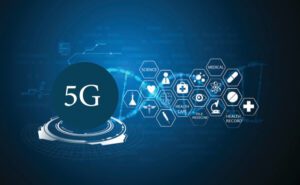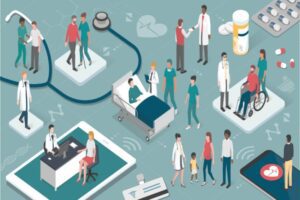Introduction
In the field of healthcare technology, we are at the start of a high-tech era. AI technology, cloud-based services, the Internet of Things, and big data have all become popular topics of conversation among healthcare professionals as a way to provide high-quality services to patients while cutting costs. Due to ambitions for global application, the fifth generation of cellular technology, or 5G, has gotten a lot of interest. While the majority of media attention has centered on the promise of “the internet of things,” the ramifications of 5G-enabled technologies in health care are yet to be addressed (Zhang and Pickwell-Macpherson, 2019). The adoption of 5G in healthcare is one of the elements that is expected to have a significant impact on patient value. 5G, or fifth-generation wireless communications, would not only provide much more capacity but also be extremely responsive owing to its low latency. 5G opens up a slew of possibilities for healthcare, including remote diagnostics, surgery, real-time surveillance, and extended telemedicine (Thayananthan, 2019). This article examines the influence of 5G technology on healthcare delivery and quality, as well as possible areas of concern with this latest tech.

What is 5G?
The fifth generation of wireless communication technology is known as 5G. Like the preceding fourth generation, the core focus of 5G is speed. Every successive generation of wireless networks improves on the previous one in terms of speed and capability. 5G networks can deliver data at speeds of up to 10 terabytes per second. Similarly, while older networks generally have a delay of 50 milliseconds, 5G networks have a latency of 1–3 milliseconds. With super-fast connection, ultra-low latency, and extensive coverage, 5G marks yet another step ahead (Carlson, 2020). From 2021 to 2026, the worldwide 5G technology market is predicted to grow at a CAGR of 122.3 percent, reaching $667.90 billion. These distinguishing characteristics of 5G enable the possible change in health care as outlined below.
5G’s Importance in Healthcare
Patient value has been steadily declining, resulting in rising healthcare spending. In addition, there is rising concern over medical resource imbalances, ineffective healthcare management, and uncomfortable medical encounters. To address these issues, technologies such as the Internet of Things (IoT), cloud technology, advanced analytics, and artificial intelligence are being developed to enhance customer care and healthcare efficiency while lowering total healthcare costs (Li, 2019). The healthcare business is likely to see the largest improvements as a result of 5G’s large bandwidth, reduced latency, and low-power-low-cost. Healthcare professionals investigated and developed several connected-care use cases, but widespread adoption was hampered by the limits of available telecommunications. High-speed and dependable connections will be critical as healthcare systems migrate to a cloud-native design. High data transfer rates, super-low latency, connection and capacity, bandwidth efficiency, and durability per unit area are some of the distinctive properties of 5G technology that have the potential to assist tackle these difficulties (Soldani et al., 2017). Healthcare stakeholders may reorganize, transition to comprehensive data-driven individualized care, improve medical resource use, provide care delivery convenience, and boost patient value thanks to 5G.

5 ways that 5G will change healthcare
- Large image files must be sent quickly.
- Expanding the use of telemedicine.
- Improving augmented reality, virtual reality, and spatial computing.
- Artificial Intelligence
Healthcare systems may enhance the quality of treatment and patient satisfaction, reduce the cost of care, and more by connecting all of these technologies over 5G networks (Att.com, 2017). 5G networks can enable providers to deliver more tailored and preventative treatment, rather than just responding to patients’ illnesses, which is why many healthcare workers joined providers during the first round.
Challenges
As with other advances, many industry professionals are cautious about 5G technology’s worldwide acceptance in healthcare, as evidenced by the following significant challenges:
- Concerns about privacy and security – The network providers must adhere to the health – care industry’s stringent privacy regulations and maintain end-to-end data protection across mobile, IoT, and connected devices.
- Compatibility of Devices – The current generation of 4G/LTE smartphones and gadgets are incompatible with the upcoming 5G networks. As a result, manufacturers have begun to release 5G-enabled smartphones and other products.
- Coverage and Deployment – The current generation of 4G/LTE smartphones and gadgets are incompatible with the upcoming 5G networks. The present 4G network uses certain frequencies on the radio frequency band, often around 6 GHz; however, such systems are available exclusively in a few nations’ metro/urban regions, and telecom carriers must create considerable equipment to overcome this difficulty (Chen et al., 2017).
- Infrastructure – As part of the 5G network needs, healthcare facilities, clinics, and other healthcare providers/organizations will need to upgrade and refresh their infrastructure, apps, technologies, and equipment.
Conclusion
5G has the potential to revolutionize healthcare as we know it. As we saw during the last epidemic, the healthcare business needs tools that can serve people from all socioeconomic backgrounds. Future improvements and gadgets based on new 5G devices and computers can stimulate healthcare transformation, expand consumer access to high-quality treatment, and help close global healthcare inequities (Thuemmler et al., 2017). For enhanced healthcare results, 5G offers network stability, speed, and scalability for telemedicine, as well as catalyzing broad adoption of cutting-edge technologies like artificial intelligence, data science, augmented reality, and the IoT. Healthcare organizations must develop, test, and deploy apps that make use of 5G’s key capabilities, such as ultra-high bandwidth, ultra-reliability, ultra-low latency, and huge machine connections.
References
- Att.com. (2017). 5 Ways 5G will Transform Healthcare | AT&T Business. [online] Available at: https://www.business.att.com/learn/updates/how-5g-will-transform-the-healthcare-industry.html.
- Carlson, E.K. (2020). What Will 5G Bring? Engineering.
- Chen, M., Yang, J., Hao, Y., Mao, S. and Hwang, K. (2017). A 5G Cognitive System for Healthcare. Big Data and Cognitive Computing, 1(1), p.2.
- Li, D. (2019). 5G and Intelligence Medicine—How the Next Generation of Wireless Technology Will Reconstruct Healthcare? Precision Clinical Medicine, 2(4).
- Soldani, D., Fadini, F., Rasanen, H., Duran, J., Niemela, T., Chandramouli, D., Hoglund, T., Doppler, K., Himanen, T., Laiho, J. and Nanavaty, N. (2017). 5G Mobile Systems for Healthcare. 2017 IEEE 85th Vehicular Technology Conference (VTC Spring).
- Thayananthan, V. (2019). Healthcare Management using ICT and IoT-based 5G. International Journal of Advanced Computer Science and Applications, 10(4).
- Thuemmler, C., Paulin, A., Jell, T. and Lim, A.K. (2017). Information Technology – Next Generation: The Impact of 5G on the Evolution of Health and Care Services. Advances in Intelligent Systems and Computing, pp.811–817.
- Zhang, Y.-T. and Pickwell-Macpherson, E. (2019). Editorial: 5G-Based mHealth Bringing Healthcare Convergence to Reality. IEEE Reviews in Biomedical Engineering, 12, pp.2–3.






